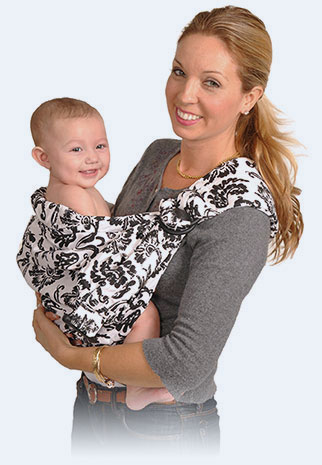
10 Tips for Comforting Colic
Colic Tips From Dr. Sears
Excerpt with permission from “The Portable Pediatrician” by Dr. Bill Sears, MD.
Traditionally, colic has been "treated" by laying a reassuring hand on the tummy of the baby and the shoulders of the parents and temporizing, "Oh, he’ll grow out of it!" Most approaches to colic are aimed more at helping parents cope than at relieving Baby’s hurt. By maintaining the mind-set "the hurting baby" rather than "the colicky baby," you and your pediatrician form a partnership to persevere in finding the cause and the remedy for your baby’s pain.
Although parents need to keep experimenting with comforting measures that work, most of them come down to motion, untensing tiny tummies, and administering the right touch at the right time. The following ten tips should help:
1. Slower, more frequent feedingsOverfeeding can increase intestinal gas from the breakdown of excessive lactose, either in Mother’s milk or formula. As a rule of thumb, feed Baby twice as often and half as much. A baby’s tummy is around the size of her fist. To appreciate the discrepancy between usual feeding volume and tummy size, place Baby’s fist next to a bottle filled with four to six ounces of formula. It’s no wonder tiny tummies get tense.
2. Colic carriesHere are some time-tested colic carries that work particularly well for fathers. We call them “favorite fuss-busters.”
- Football hold. Drape Baby stomach-down along your forearm. Place Baby’s head near the crook of your elbow and his legs straddling your hand. Grasp the diaper area firmly and press your forearm into Baby’s tense abdomen. Or you can try reversing this position so that his cheek lies in the palm of your hand, his abdomen along your forearm, and his crotch area snuggled into the crook of your elbow.
- The neck nestle. Snuggle Baby’s head into the groove between your chin and chest. While swaying back and forth, croon a low, slow, repetitive tune, such as “Old Man River.”
The choreography that works best to contain colic is movement in all three planes: up and down, side to side, and fonvard and backward-essentially the movement that baby was used to while in the womb. Common dance positions are the neck nestle, the football hold, and the colic curl (described below). Our favorite colic-soothing dance is one we call "the elevator step." Bounce up and down, heel to toe, stepping at a rate of sixty to seventy beats per minute (count "one-and-a two-and-a …"). This rhythm corresponds to the uterine blood flow pulse rate that Baby was used to. A comforting ritual that works for many is one we call the "dinner dance." Some babies love to breastfeed in the sling while you dance. Your movement, plus Baby’s sucking, is a winning combination for settling even the most upset baby. Babies usually prefer dancing with Mother. After all, she is the dance partner Baby came to know even before birth. This explains why some fathers get frustrated when they try to cut in, offering some relief to worn-out dancing moms. Nevertheless, many fussy babies like a change in routine and welcome Dad’s different holds and steps. And don’t forget to invite Grandmother to the dance. She has patient and experienced arms and probably some pretty fancy footwork from her days as a baby-dancer.
4. Baby bends
When Baby is at the peak of an attack, here are two time-tested favorites:
- The gas pump. Lay Baby on her back on your lap with her legs toward you and her head resting on your knees. Pump her legs up and down in a bicycling motion while adding a few attention-getting facial antics.
- The colic curl. This is a favorite of babies who tense their tummies and arch their backs. Hold Baby in a sitting position facing forward in front of you and fold your arms under his bottom. Lay Baby back so his head and upper back are against your chest with his lower body curled slightly upward in front of you. Or, try reversing this forward-facing position: Baby’s feet up against your chest as you hold him. In this position, you can maintain eye contact and play facial-gesture games with your baby.
5. Baby bounces
While laying a securing hand on Baby’s back, drape him tummy-down over a large beach ball and roll him back and forth in a circular motion. If you have a large beach ball (or purchase a “physic ball” from an infant product catalog), use it for the baby bounce. Hold Baby securely and close enough to engage in an eye-to-eye gaze and slowly bounce up and down while sitting on the ball. We (Dr. Bill and Martha) still have “the big red ball” rolling around our house as a memento of our bouncing past. We used to call it “kangaroo time.” A father in our practice scheduled his daily exercise routine during Baby’s evening fussy times. While holding Baby in the neck nestle position, he bounced gently and rhythmically on a small trampoline. This took the tension out of Baby and pounds off Daddy. Parents would need to take special care to keep their balance and make sure Baby isn’t bouncing too hard.
DR. SEARS TIP
Get Relief-for Mom!If your baby’s fussiness is getting to you to the extent that your losing your mercy, it’s time to get some relief. One time a mother who was burning out from comforting her fussy baby came into our office with her fussy baby and her two-year-old, who was sporting a T-shirt that said, “Mom is having a bad day. Call 1-800-GRANDMA.”
Place a rolled-up cloth diaper or a warm-water bottle (not hot!) enclosed in a cloth diaper under Baby’s tummy during gas pain. To further relax a tense tiny tummy, lay Baby stomach-down on a cushion with her legs dangling over the edge while rubbing her back.
7. Tummy touchesPlace the palm of your hand over Baby’s navel and let your fingers and thumb encircle Baby’s abdomen. Let Baby lean her tense abdomen against your warm hand. Dad’s bigger hands provide an added touch. Practice the “I love U” touch. This is a time-tested infant-massage technique. Picture an upside-down “U” over the surface of your baby’s abdomen. Underneath are your baby’s tense intestines, which need relaxing, out of which you are trying to massage the gas. Rub some warm massage oil on your hands and knead Baby’s tense abdomen with your flattened fingers in a circular motion. Start with a downward stroke for the “I” on Baby’s left side, then massage along the upside-down “L” along the top of your baby’s abdomen, and then massage along the upside-down “U,” stroking upward along the right, across, and down the left side. Try this abdominal massage with Baby on your lap and his feet facing you.
8. Warm touchesTry the warm-fuzzy (another favorite for dads). While lying on a bed or floor, drape Baby tummy-to-tummy, skin-to-skin with her ear over your heartbeat. The warmth of your body plus the rise and fall of your chest is a proven fussbuster. Taking a warm bath together in this position can be extra soothing.
 9. Babywearing
9. Babywearing
The most time-tested method for calming colic is wearing Baby in a sling during fussy periods or, preferably, as a preventive measure before the evening outburst. Anthropologists who have studied infant care practices throughout the world have noted the correlation that carried babies fuss less. We use the term babywearing because wearing means more than just picking up Baby and putting her in a carrier when she fusses. It means carrying Baby several hours a day before Baby needs to fuss. Mothers who do this tell us, “My baby seems to forget to fuss.” One mother in our practice had a colicky baby who was content as long as she was in a sling. But she had to return to work when her baby was six weeks of age. I wrote the following “prescription” to give to her daycare provider: “To keep Baby content, wear her in a sling at least three hours a day.”
One theory about colic is that it is a symptom of disorganized biorhythms. During the nine prenatal months, the womb environment regulates Baby’s systems automatically. Birth temporarily disrupts this organization. The more quickly Baby gets outside help with organizing these systems, the more easily she adapts to the puzzle of life outside the womb. By extending the womb experience, the babywearing mother and father provide an external regulating system that balances the irregular and disorganized tendencies of a baby. It helps to think of the womb experience lasting eighteen months-nine months inside the mother and nine months outside. An experienced babywearing mother in our practice believes that wearing her baby after a feeding promotes “digestive organization.”
10. Magic mirrorThis trick has pulled many of the babies in our practice out of crying jags. Hold the colicky baby in front of a mirror and let him witness his own drama. Place his hand or bare foot against his image on the mirror surface and watch the intrigued baby grow silent.
When Will It Stop?
Seldom do the colicky outbursts continue past four to six months of age, although some fussy behavior may last throughout the first year. By six months of age, exciting developmental changes occur that lead babies to the promised land of colic-free living. They can see clearly across the room; babies are so delighted by the visual attractions that they forget to fuss. They can play with their hands and engage in self-soothing finger-sucking. Babies can enjoy more freedom to wave their limbs freestyle and blow off steam. Also, during the second half of the first year, Baby’s intestine is more mature, and food allergies and reflux subside. If you are right in the middle of the colicky months, it’s hard to imagine that the crying will ever end. But it will. Hang in there. Rely on some help from others to get you through. In just a short time, your baby will be consistently happy again, and you can move on and enjoy parenthood.
DR. SEARS TIP
Plan Ahead for “Happy Hour”Colicky babies seem to go to pieces in the late afternoon or early evening and, by a quirk of injustice, at the very moment when your parental reserves are already drained. If your baby is a “p.m. fusser,” plan ahead for “happy hour” before Baby’s colic occurs. Prepare the evening meal in advance. Frozen, precooked casseroles are ideal meals during the colicky stage. Treat Baby and yourself to a late-afternoon nap. Upon awakening, go immediately into a relaxing ritual, such as a twenty-minute baby massage, followed by a forty-minute walk with Baby in a sling (a good time for your exercise). With this before-colic ritual, Baby is conditioned at the same time each day to expect an hour of pleasure rather than an hour of pain.
 Canada
Canada South Africa
South Africa UK
UK EU & Int
EU & Int Ireland
Ireland Australia
Australia Brazil
Brazil New Zealand
New Zealand
